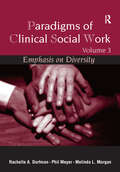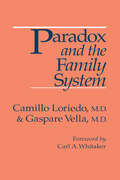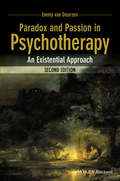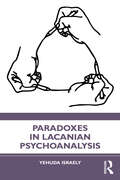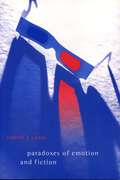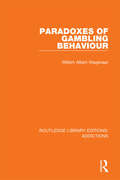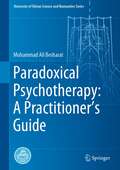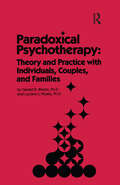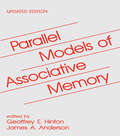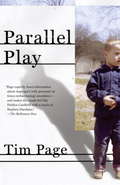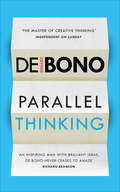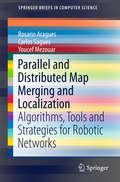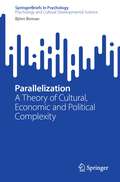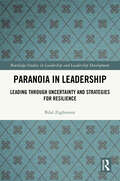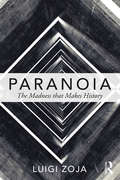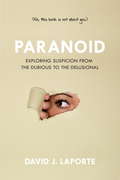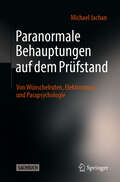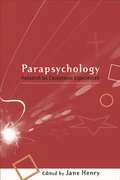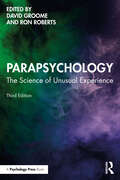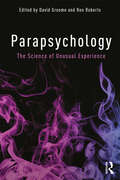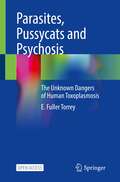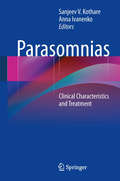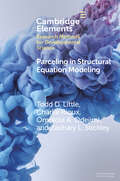- Table View
- List View
Paradigms of Clinical Social Work: Emphasis on Diversity
by Rachelle A. Dorfman-Zukerman Melinda L. Morgan Phil MeyerDesigned to mirror how social work theory and practice is taught, Paradigms of Clinical Social Work, Volume 3 presents new therapeutic models through an imaginary family experiencing common social work problems.
Paradox And The Family System
by Camillo Loriedo Gaspare VellaFirst published in 1992. Routledge is an imprint of Taylor & Francis, an informa company.
Paradox and Passion in Psychotherapy
by Emmy Van DeurzenParadox and Passion in Psychotherapy , second edition, is a fully updated edition of a classic guide to existential psychotherapy by one of its leading practitioner. Examines the personal and subjective dimensions of psychotherapy in a fresh and bold manner Offers practical and common-sense approaches to tackling sensitive issues when working with clients with an emphasis on transparency and authenticity Weaves together concepts of existential psychotherapy with case studies and the author's experiential observations in a seamless narrative Covers a wide range of intimate existential issues, including loneliness, survival, self-understanding, love, and passion
Paradoxes in Lacanian Psychoanalysis
by Yehuda IsraelyThis book explores the nature of paradoxes in Lacanian psychoanalysis, how they can be approached in treatment and how they can be resolved. Building on Freud’s and Lacan’s own work in resolving paradoxes, Yehuda Israely considers psychic distress, and its amelioration, by means of the study and clarification of the many life situations that can be described as paradoxical. Among the paradoxes examined in this book are the nature of longing (the object’s presence in its absence), the wholeness of the broken heart (the subject’s existence in relation to the lack that defines her or him), drives (the more you feed it, the hungrier it gets) and the pangs of conscience (the righteous suffer). Israely’s innovative approach considers several questions which can be used to orient treatment and focuses on shedding the erroneous beliefs and assumptions that can lead to dead ends. Paradoxes in Lacanian Psychoanalysis also explores those paradoxes – involving anxiety, perplexity, wonder and creativity – that cannot and are not meant to be resolved. This fascinating book will be essential reading for Lacanian psychoanalysts in practice and in training, and for psychoanalysts and psychotherapists of other theoretical backgrounds who are interested in understanding the nature of paradoxes.
Paradoxes of Emotion and Fiction (G - Reference, Information and Interdisciplinary Subjects)
by Robert J. YanalHow can we experience real emotions when viewing a movie or reading a novel or watching a play when we know the characters whose actions have this effect on us do not exist? This is a conundrum that has puzzled philosophers for a long time, and in this book Robert Yanal both canvasses previously proposed solutions to it and offers one of his own.First formulated by Samuel Johnson, the paradox received its most famous answer from Samuel Taylor Coleridge, who advised his readers to engage in a "willing suspension of disbelief." More recently, philosophers have argued that we are irrational in emoting toward fiction, or that we do not emote toward fiction but rather toward factual counterparts, or that we do not have real but only quasi-emotion toward fiction, generated by our playing games of make-believe. All of these proposed solutions are critically reviewed.Finding these answers unsatisfactory, Yanal offers an alternative, providing a new version of what has been dubbed "thought theory." On this theory, mere thoughts not believed true are seen as the functional equivalent of belief at least insofar as stimulating emotion is concerned. The emoter's disbelief in the actuality of components of the thoughts must be rendered relatively inactive. Such emotion is real and typically has the character of being richly generated yet unconsummated.The book extends this theory also to resolving other paradoxes arising from emotional response to fiction: how we feel suspense over what comes next in a story even when we are re-reading it for a second or third time; and how we take pleasure in narratives, such as tragedy, that excite unpleasant emotions such as fear, pity, or horror.
Paradoxes of Gambling Behaviour (Routledge Library Editions: Addictions)
by Willem A. WagenaarWhy does a large proportion of the population engage in some form of gambling, although they know they are most likely to lose, and that the gambling industry makes huge profits? Do gamblers simply accept their losses as fate, or do they believe that they will be able to overcome the negative odds in some miraculous way? The paradox is complicated by the fact that those habitual gamblers who are most aware that systematic losses cannot be avoided, are the least likely to stop gambling. Detailed analyses of actual gambling behaviour have shown gamblers to be victims of a variety of cognitive illusions, which lead them to believe that the general statistical rules of determining the probability of loss do not apply to them as individuals. The designers of gambling games cleverly exploit these illusions in order to promote a false perception of the situation. Much of the earlier interest in gambling behaviour has been centred on the traditional theories of human decision-making, where decisions are portrayed as choices among bets. This led to a tradition of studying decision-making in experiments on betting. In this title, originally published in 1988, the author argues that betting behaviour should not be used as a typical example of human decision-making upon which a general psychological theory could be founded, and that these traditional views can in no way account for the gambling behaviour reported in this book.
Paradoxical Psychotherapy: A Practitioner’s Guide (University of Tehran Science and Humanities Series)
by Mohammad Ali BesharatThis book reports the results of an evidence-based case study for mental disorders which show that PTC has been very successful in bringing about deep and constant therapeutic changes. In response to the need of a more efficient approach for the treatment of psychological disorders, especially the broad spectrum of anxiety disorders, the PTC psychotherapeutic model was developed.Results of the follow-up studies reported in the present book show that the relapse rate in this model is in its lowest level compared to other psychotherapeutic approaches.Simple nature of the PTC protocol, described within the present book, allows psychotherapists and clinical practitioners to use this newly developed psychotherapy model for the treatment of mental disorders.This newly developed psychotherapy model can be applied to new developments in the field of psychotherapy theory, research, and practice.All psychotherapy associations, psychotherapy societies, psychological associations, psychotherapy societies, healthcare organizations, and academic libraries are likely to be part of the readership of this book.
Paradoxical Psychotherapy: Theory & Practice With Individuals Couples & Families
by Luciano L'Abate Gerald R. WeeksFirst published in 1982. Paradoxical psychotherapy has rapidly become one of the most· important approaches to family therapy and psychotherapy during the past few years. The aim of this book is to present an overview of paradoxical therapy. Paradoxical Psychotherapy: Theory and Practice with Individuals, Couples, and Families Is designed for all clinical psychologists. Applications are offered for the individual, marital, and family therapist.
Parallel Models of Associative Memory: Updated Edition
by James A. Anderson Geoffrey E. HintonThis update of the 1981 classic on neural networks includes new commentaries by the authors that show how the original ideas are related to subsequent developments. As researchers continue to uncover ways of applying the complex information processing abilities of neural networks, they give these models an exciting future which may well involve revolutionary developments in understanding the brain and the mind -- developments that may allow researchers to build adaptive intelligent machines. The original chapters show where the ideas came from and the new commentaries show where they are going.
Parallel Play: Growing Up with Undiagnosed Asperger's
by Tim PageIn this captivating memoir, Pulitzer Prize-winner Page writes about growing up gifted and unknowingly suffering from Asperger's syndrome, expanding on a tremendously popular essay he wrote for "The New Yorker. "
Parallel and Distributed Map Merging and Localization
by Rosario Aragues Carlos Sagues Youcef MezouarThis work examines the challenges of distributed map merging and localization in multi-robot systems, which enables robots to acquire the knowledge of their surroundings needed to carry out coordinated tasks. After identifying the main issues associated with this problem, each chapter introduces a different distributed strategy for solving them. In addition to presenting a review of distributed algorithms for perception in localization and map merging, the text also provides the reader with the necessary tools for proposing new solutions to problems of multi-robot perception, as well as other interesting topics related to multi-robot scenarios. The coverage is largely self-contained, supported by numerous explanations and demonstrations, although references for further study are also supplied. The reader will not require any prior background knowledge, other than a basic understanding of mathematics at a graduate-student level.
Parallelization: A Theory of Cultural, Economic and Political Complexity (SpringerBriefs in Psychology)
by Björn BomanThis SpringerBrief is an extension of the article "Parallelization: the fourth leg of cultural globalization theory" (Integrative Psychological and Behavioral Science, 2021) by Dr. Björn Boman. The original article consisted of four main examples of parallelization, and has been expanded to include chapters on Korea, Russia-Ukraine, and Georgia. This book points to the relations between oppositely directed processes and the need for theoretical modelling of complex societal processes.
Parando a missão suicida: ... e de quem é a vida?
by Madhu RondaEste pequeno livro destina-se a servir um grande passo no sentido de capacitar uma pessoa (masculino/feminino). A vida é preciosa. É tão precioso que você só sabe o seu real valor antes de perdê-lo para sempre. Este livro tabula categoricamente fatos sobre o ato hediondo de suicídio em todo o mundo. É apontado que apenas os jovens ocupam maior porcentagem de casos propensos ao suicídio. Finalmente, o livro abre opções para não sucumbir ao ato de tirar a vida.
Paranoia & Heartbreak: Fifteen Years in a Juvenile Facility
by Jerome GoldFor fifteen years, Jerome Gold worked as a rehabilitation counselor in a prison for juveniles in Washington state. Throughout his time there, he kept a journal of his experiences with youths who had been incarcerated for murder, kidnap, assault, rape and other sex offenses, auto theft, burglary, and selling drugs. What started as a journal designed to relieve stress turned into the evocation of one man's nuanced perspective on a unique group of young people. Paranoia & Heartbreak tells Gold's personal story of coming to terms with people who have crossed over to the other side of their own humanity. Writing from ample experience and with unflinching compassion, Gold brings the reader to see these "deviants"--and through them, in some slanted way, our whole society, with an unexpected intensity.
Paranoia in Leadership: Leading Through Uncertainty and Strategies for Resilience (Routledge Studies in Leadership and Leadership Development)
by Bilal ZaghmoutLeadership has emerged as a cornerstone of progress and transformation in organizations and societies in a world marked by constant change and ambiguity. However, one of the most formidable challenges leaders face is paranoia in leadership. This book is a profound exploration of this enigmatic phenomenon that plagues leaders and organisations, offering insights, solutions, and guidance for those navigating the complex terrain of leadership. With its unique focus on navigating paranoia within the context of leadership, this book delves explicitly into the nuanced challenge of paranoia. It offers practical insights and strategies for leaders to navigate and thrive in uncertain environments. It dissects the multifaceted nature of paranoia in leadership, delves into its psychological underpinnings, and provides practical strategies for mitigating its impact. By offering a comprehensive understanding of how to lead with resilience and trust, the book empowers leaders to confidently navigate the complexities of leadership in a world marked by uncertainty. It will be of interest to researchers, academics, practitioners, and students in the fields of leadership, organisational studies, psychology, and sociology.
Paranoia: The madness that makes history
by Luigi ZojaLuigi Zoja presents an insightful analysis of the use and misuse of paranoia throughout history and in contemporary society. Zoja combines history with depth psychology, contemporary politics and tragic literature, resulting in a clear and balanced analysis presented with rare clarity. The devastating impact of paranoia on societies is explored in detail. Focusing on the contagious aspects of paranoia and its infectious, self-replicating dynamics, Zoja takes such diverse examples as Ajax and George W. Bush, Cain and the American Holocaust, Hitler, Stalin and Othello to illustrate his argument. He reconstructs the emblematic arguments that paranoia has promoted in Western history and examines how the power of the modern media and mass communication has affected how it spreads. Paranoia clearly examines how leaders lose control of their influence, how the collective unconscious acquires an autonomous life and how seductive its effects can be - more so than any political, religious or ideological discourse. This gripping study will be essential reading for depth and analytical psychologists, and academics and students of history, cultural studies, psychology, classical studies, literary studies, anthropology and sociology.
Paranoid
by David J. Laporte William T. CarpenterFrom the pathological killer who gunned down the innocents at Virginia Tech to the average citizen who suspects the government is monitoring phone calls, the signs of suspiciousness and paranoia are all around us. In this comprehensive overview of an increasingly serious problem, an experienced psychologist and researcher describes what paranoia is, how and why it manifests itself, and the many forms it takes, including stalking, pathological jealousy, as a reaction to post-traumatic stress disorder, and perhaps even militia movements. Using striking vignettes from the present and the past, each chapter illustrates specific manifestations of paranoia while also describing in layperson's terms the clinical analysis of the condition. Among the topics discussed are the evolutionary origins of our "suspiciousness system" and factors that can trigger it today, the connection between illicit drug usage and paranoid behavior, PTSD, violent expressions of paranoia, and options for treating various kinds of paranoia.The author emphasizes that life in post-9/11 America is a fertile environment for paranoia; in an era of computer hackers, omnipresent security cameras, NSA surveillance, and terrorism, "normal" people have good reasons to be suspicious as their sense of security and privacy is undermined. But in such an insecure atmosphere, everyday suspicion can easily be ratcheted up, resulting in paranoia and occasionally violent outbursts. He warns of a possible epidemic of paranoia and suggests public health measures that could be used to counteract this potentially dangerous trend.Whether you consider yourself susceptible to paranoia or know others who might be, this enlightening book will help you understand the many factors that can distort your mental outlook.From the Trade Paperback edition.
Paranormale Behauptungen auf dem Prüfstand: Von Wünschelruten, Elektrosmog und Parapsychologie
by Michael JachanDieses Sachbuch bietet eine tiefgehende und verständliche Einführung in die Welt der Wissenschaft und Pseudowissenschaften. Mit praktischen Anleitungen zur Durchführung von Psi-Tests zu Hause, die nur Papier, Bleistift und eine Münze benötigen, vermittelt es auf einfache Weise die Prinzipien wissenschaftlicher Untersuchungen. Lerne, wie Wissenschaftler*innen im Labor arbeiten, und, wie diese Techniken auf alltägliche Behauptungen angewendet werden können. Erfahre etwas über die skurrilen und oft irrtümlichen Überzeugungen, die auch renommierte Wissenschaftler*innen immer wieder hegen. Mit Themen wie Pseudowissenschaft, Doppelblindversuch, Placebo-Effekt, Psi-Test, Elektrosensibilität, Geistheilung und mehr, spannt das Buch einen Bogen von den alten Griechen über Isaac Newton bis ins 21. Jahrhundert. Es vermittelt die Grundlagen der Wissenschaftsgeschichte sowie -theorie und bietet einen praxisnahen Einblick in die Durchführung von Experimenten. Ein besonderes Augenmerk liegt auf der Problemlösung: Leser*innen werden befähigt, sich und ihr Umfeld vor Scharlatan*innen zu schützen, indem sie lernen, paranormale Behauptungen kritisch zu hinterfragen. Entdecke, ob hinter Esoterik und Pseudomedizin tatsächlich etwas steckt und wie du mit wissenschaftlichen Methoden zu einer fundierten Beurteilung gelangen kannst.
Parapsychology: Research on Exceptional Experiences
by Jane HenryPsychic and other exceptional experiences are surprisingly common but opinions as to their causes vary widely. Can tricks of the mind such as hallucinations, mistaken perception and errors of judgement explain such phenomena or does some yet to be understood non-sensory means of communication come into play? In Parapsychology, leading researchers from both the UK and the USA combine their expertise to form a lucid account of research into the science of psychic experience. Beginning with an introduction to the methodology, Parapsychology addresses topics including coincidence, telepathy, precognition, psychokinesis, healing, apparitions, reincarnation and out-of-body experiences. Each chapter describes the phenomenon, outlines the main lines of research and discusses the merits of possible explanations for such anomalies of cognitive function. Extensive suggestions for relevant further reading on each individual subject are provided, along with a detailed glossary of terms. Parapsychology provides an accessible and succinct overview of the research and current thinking on the subject of psychic and allied experiences. This balanced account of work in this fascinating area will be of great interest to students and researchers in psychology as well as anyone with an interest in the field.
Parapsychology: The Science of Unusual Experience
by David Groome Ron RobertsThis new edition of Parapsychology continues to challenge and provoke readers with some of psychology’s most puzzling phenomena. Whether believers or sceptics, the book provides readers with the opportunity to further their understanding of the paranormal, bridging the gap between traditional psychology and fringe areas.With contributions from leading paranormal researchers, this edition has been thoroughly updated and includes new chapters on dreams, precognition and prediction of future events and anthropology. The book has been reorganised to help readers frame each phenomenon within the context of cognition, science and religion, and chapters are structured around science and experience, cognition and belief, religious belief and science, and further topics in parapsychology. The book covers a range of topics that can be considered parapsychological; including reincarnation, entity encounters, astrology, mediumship and near-death experiences.Providing a balanced introduction to parapsychology that explores the strengths and limitations of scientific investigation, this is essential reading for students and professionals in the field, along with anyone interested in learning more about the science of the paranormal.
Parapsychology: The Science of Unusual Experience (A\hodder Arnold Publication)
by David Groome Ron RobertsContaining contributions from leading paranormal researchers, this edition of Parapsychology continues to challenge and provoke readers with some of psychology’s most puzzling phenomena. Whether believers or sceptics, the book provides readers with the opportunity to further their understanding of the paranormal, bridging the gap between traditional psychology and its so-called fringe areas. Featuring updates to many of the original chapters, this book brings readers up to date with the wealth of radical research in the field. This edition also includes several new chapters, covering subjects as diverse as possession and exorcism, conspiracy theories, reincarnation, and religious belief, many of which are extremely relevant in the world today. Drawing on a range of research, the book provides a balanced introduction to parapsychology, exploring the strengths and limitations of scientific investigation itself. Parapsychology is for readers from a variety of backgrounds: professionals in the field, students, lay readers and anyone who wants to understand what the paranormal can tell us about ourselves. A variety of viewpoints are on offer, with the emphasis on the reader to make up their own mind. Prepared to be unsettled, again…
Parasites, Pussycats and Psychosis: The Unknown Dangers of Human Toxoplasmosis
by E. Fuller TorreyThis open access book analyzes the evidence linking Toxoplasma gondii to the increasing incidence of schizophrenia and bipolar disorder in the United States. Initially establishing that infectious agents are regularly transmitted from animals to humans, lead to human disease, and that infectious agents can cause psychosis, it then examines the protozoan parasite Toxoplasma gondii in detail. Infecting 40 million Americans, Toxoplasma gondii is known to cause congenital infections, eye disease, and encephalitis for individuals who are immunosuppressed. It has also been shown to change the behavior of nonhuman mammals, as well as to alter some personality traits in humans. After discussing the clinical evidence linking Toxoplasma gondii to human psychosis, the book elucidates the epidemiological evidence further supporting this linkage; including the proportional increase in incidence of human psychosis as cats transitioned to domestication over 800 years. Finally, the book assesses the magnitude of the problem and suggests solutions.Parasites, Pussycats and Psychosis: The Unknown Dangers of Human Toxoplasmosis provides a comprehensive review of the evidence linking human psychosis in the United States to infections of Toxoplasma gondii. It will be of interest to infectious disease specialists, general practitioners, scientists, historians, and cat-lovers.
Parasomnias: Clinical Characteristics and Treatment
by Sanjeev V. Kothare Anna IvanenkoParasomnias are phenomena that occur exclusively during sleep or are exacerbated during sleep/wake transition. These disorders are known to contribute towards impaired quality of life, disturbed and non-restorartive sleep, risk for injuries to self and others, and often associated with other medical, neurological, and psychiatric disorders. Advances in sleep medicine have revealed a high prevalence of parasomnias across all ages. With the growing interest for diagnosing and management of parasomnias in sleep medicine, a practical guide to parasomnias is greatly needed. Parasomnias provides a comprehensive review of epidemiology, pathophysiology, clinical characteristics, diagnostic evaluation and treatment of parasomnias across the patient's life span. Written by experts, each chapter integrates the latest research and clinical data. In addition, several chapters address medico-legal and forensic aspects of parasomnias. Clinicians and researchers with an interest in sleep medicine will find Parasomnias to not only be an important contribution to the literature, but an indispensible guide to identifying, understanding and treating this disorder.
Parceling in Structural Equation Modeling: A Comprehensive Introduction for Developmental Scientists (Elements in Research Methods for Developmental Science)
by Todd D. Little Charlie Rioux Omolola A. Odejimi Zachary L. StickleyParceling is pre-modeling strategy to create fewer and more reliable indicators of constructs for use with latent variable models. Parceling is particularly useful for developmental scientists because longitudinal models can become quite complex and even intractable when measurement models of items are fit. In this Element the authors provide a detailed account of the advantages of using parcels, their potential pitfalls, as well as the techniques for creating them for conducting latent variable structural equation modeling (SEM) in the context of the developmental sciences. They finish with a review of the recent use of parcels in developmental journals. Although they focus on developmental applications of parceling, parceling is also highly applicable to any discipline that uses latent variable SEM.
